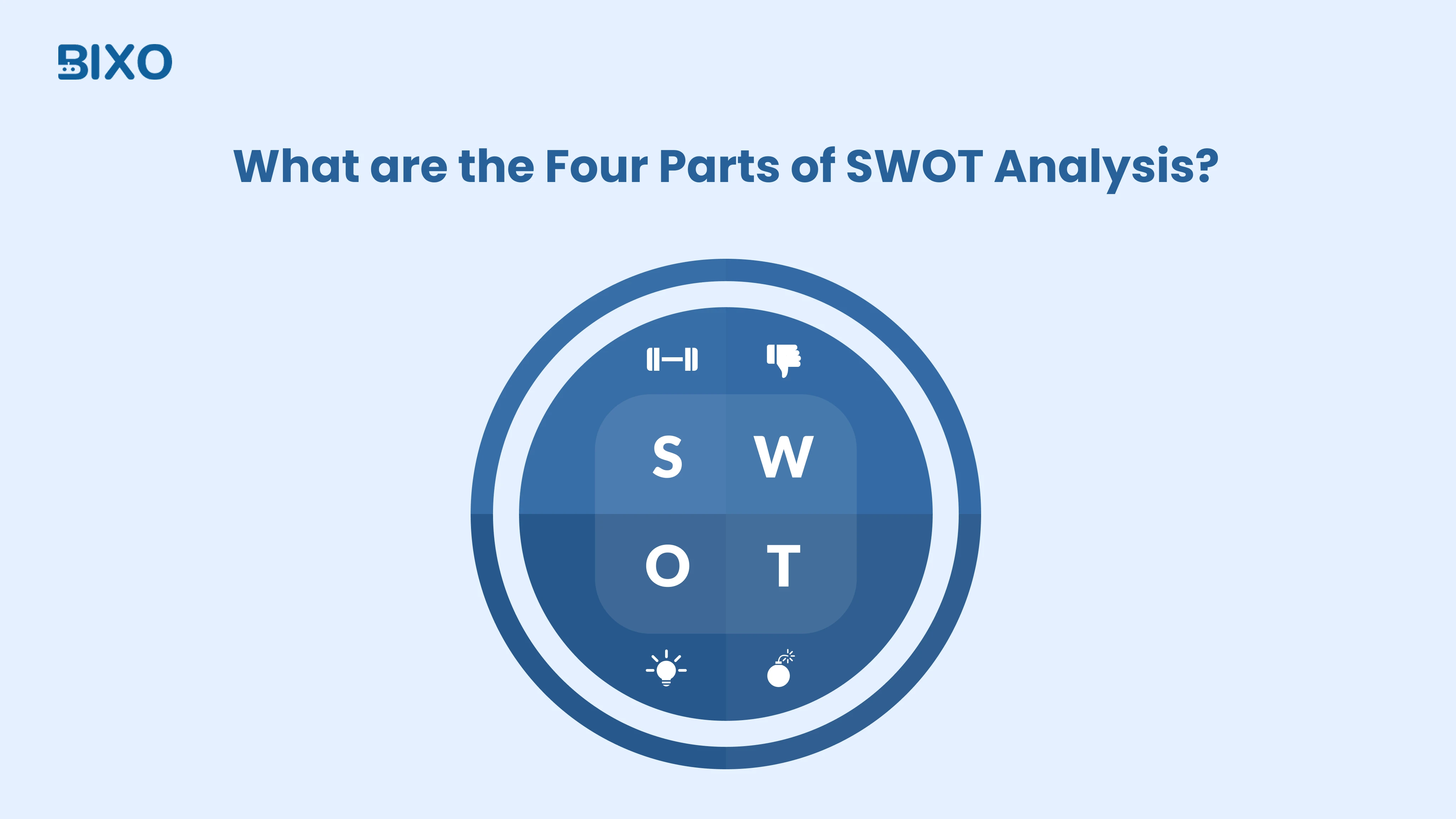
Table of Content
Focus on what matters. BIXO handles the rest!

When you don’t see the full picture, decisions can feel uncertain and risky. You might miss what’s holding you back or overlook new chances to grow. A SWOT analysis helps by looking at your strengths, weaknesses, opportunities, and threats. It gives you a clear view of your current situation. With this insight, you can spot what to improve and what to focus on. This clarity makes it easier to take the next steps confidently.
This guide shows what a SWOT analysis is, its importance, and the four key parts of how a SWOT analysis gives a clear picture of your business or project with practical examples. It helps you plan smarter and act with clarity.
What Is a SWOT Analysis?
A SWOT analysis is a simple way to understand where you stand. It assists you in determining what you are doing right (your strengths), what you need to work on (your weaknesses), what new opportunities are generating (opportunities), and what things might stand in your path (threats).
It is usually used by businesses owners to plan more effectively, but can also be applied to personal projects or objectives. A SWOT analysis provides clarity, no matter if you’re building something new or improving what you already have.
The Four Parts of SWOT Analysis
A SWOT analysis looks at four main parts: strengths, weaknesses, opportunities, and threats. It helps you spot what’s working, identify areas to improve, recognise new possibilities, and prepare for challenges. This way, you can make focused decisions and move forward confidently.
Let’s look at each one so you can see how it can help you uncover what is working and what isn’t.

Strengths
In SWOT analysis, strengths are those you are already good at. They are the aspects in which your business/ project is unique. It could be a good team, loyal customers, a solid brand identity or something special that gives you a competitive edge.
Looking at your strengths helps you understand what’s working and how you can use those strong points to support areas that need a boost, like improving your workflow or growing your customer base.
Here are a few simple questions to help you identify your strengths:
- Which things do we handle really well?
- What makes us stand out from others?
- Why do people choose us over competitors?
- What customers love most about us?
Weaknesses
The weaknesses are the areas that are not going well or require improvement. These might include skill gaps in your team, a lack of proper tools, unclear processes, or anything that makes things move slowly or introduces mistakes.
How to identify them?
Ask yourself questions like:
- What activities or fields can necessarily slow you down or make you frustrated?
- Are there any complaints we keep hearing from customers or team members?
- Where are we falling behind compared to others in the same space?
Opportunities
Opportunities are the exciting chances waiting outside your business or project. These are opportunities around you, whether it is a new trend, changing customer needs, or greater technology, which you can utilise to grow or improve. You might notice a new group of people who could really use the opportunities that you offer them.
There could be people who don’t know you yet but would love what you offer. If your competitors are missing something, you have a chance to fill that gap. Even small things, like what people are buying or talking about, can show you new opportunities.
Threats
Threats are outside factors that might slow you down or create problems. This might be the entry of new competitors into the market, changing customer behaviour, economic changes, or even a sudden drop in demand.
You can’t stop every problem, but noticing them early gives you time to prepare. This helps you handle challenges without stress and keeps your projects running smoothly.
Why Is a SWOT Analysis Important?
A SWOT analysis helps you get clear on where things stand, what’s working, what’s not, and what’s coming your way. Whether you are in business or working on a personal project, it will give you time to stop and think intelligently.
Here's why it matters:
- Helps make better decisions: When you know your strengths and weaknesses, it’s easier to figure out your next steps. You can move forward with confidence and avoid mistakes that could slow you down.
- Prepares you for challenges: Spotting possible risks early on gives you the chance to handle them before they turn into bigger problems. This keeps your project or team running smoothly.
- Reveals new opportunities: Looking closely at your situation can show new ways to grow, improve, or reach more people, things you might not have noticed otherwise.
- Brings clarity: Instead of feeling stuck or unsure, a SWOT analysis shows what’s working, what’s not, and where you should focus your energy to get the best results.
- Keeps you focused: Knowing your priorities helps you and your team pay attention to what really matters, make smarter choices, and keep moving forward without unnecessary stress.
Steps to Create a SWOT Analysis
Creating a SWOT analysis is about taking a moment to honestly look at where your business or project stands. It’s not complicated, and it’s a simple way to understand your situation better and make smarter decisions.
Here’s how to do it step by step:

Define Your Objective
Before you start your SWOT analysis, be clear on why you are doing it. Are you planning a new product, thinking about expanding, or simply trying to understand how your business is performing? Knowing your goal helps everyone stay focused and ensures the analysis gives you a clear view of what to do next.
Gather the Right People
Don’t do it by yourself. Include team members from different roles or departments so you can see the situation from different angles and get better insights. One person might know where projects get stuck, while someone else sees where things shine. When you mix those perspectives, you get a clearer picture of what’s really going on. When everyone feels heard, you get better ideas and more honest answers.
Collect the Info You Need
Don’t just go by what you feel; use real information to guide you. Look at what you already have, like customer reviews, team feedback, competitor info and sales numbers. All these small details help you understand what’s really going on.
Build Your SWOT Table
Use a simple 2x2 grid. One box each for strengths, weaknesses, opportunities, and threats. It makes everything easier to see and understand at a glance. If you’re working with your team in person, using sticky notes or a whiteboard can help you organise ideas and visualise the SWOT clearly.
Review and Take Action
Once your SWOT is laid out, take time to look it over carefully. Think about how your strengths can help you grab new opportunities or handle threats. Also, consider how you can fix weaknesses that might be holding you back. Apply these ideas to create an actionable plan with steps you can take. Just remember, a SWOT is only good if it leads to action.
When Should You Use a SWOT Analysis?
A SWOT analysis is helpful whenever you need a clear picture of your situation before making decisions. For instance, if your team is starting a new project or facing tight deadlines, SWOT helps you see what’s working and what could cause problems. Your strengths, like a skilled team or good communication, and weaknesses, such as limited time or unclear roles, become clear. You can also spot opportunities, like trying a new workflow tool or learning a helpful skill, and plan for things that might go wrong.
Using SWOT in these moments helps you plan smarter, assign tasks more effectively, and avoid surprises. It keeps your workflow smooth and makes it easier for your team to achieve results without unnecessary stress.
Benefits and Limitations of SWOT Analysis
A SWOT analysis is a handy tool that helps you see the big picture clearly. It helps you clearly see what’s working, what needs fixing, and where opportunities and risks lie. While SWOT analysis is very useful, understanding its limits helps you use it in the best way and make smarter decisions for your business or project.
Benefits
- Brings different people’s ideas together to work better as a team.
- Supports smarter choices by weighing your strengths against possible risks.
- It makes you focus on what truly matters.
- Provides an easy overview of the current situation.
- Creates trust by converting ideas into simple plans.
Limitations
- The results depend on how honest and thorough you are.
- It doesn’t tell you how to fix problems, just tells you what they are.
- Sometimes, it focuses too much on the present and not enough on the future.
- Sudden changes within your team or how you work might not be captured.
- External factors like competitors or market changes might be missed.
SWOT Analysis Examples
Seeing how real companies use SWOT analysis makes it easier to understand how it works. It gives you a simple way to learn and get ideas for your own business or project. Here’s a quick look at how Apple and Netflix use their strengths and spot areas to improve.

Apple SWOT Analysis
Apple is famous for making high-quality devices like iPhones and MacBooks that millions love. Their brand is strong and trusted worldwide, which gives them a big advantage.
- Strengths: Apple products are associated with fantastic design and stability. They have a loyal customer base and a connected system of products and services that work well together.
- Weaknesses: Their products tend to be pricier than others, which might turn some buyers away. They also depend a lot on iPhone sales for most of their income.
- Opportunities: Apple is able to expand in terms of the services it offers, such as streaming and financial tools. There’s also potential to reach more customers in new markets.
- Threats: Competition with other technological companies and issues such as trade might drag them down.
Netflix SWOT Analysis
Netflix is one of the top known names in streaming and is loved around the world for its original shows and variety of content that keeps people coming back.
- Strengths: Netflix owns millions of subscribers and has a strong brand. Their original programs and films reach many audiences.
- Weaknesses: Developing new material is very expensive. In addition, the number of streaming services has increased, which creates greater competition.
- Opportunities: Opportunity to expand through providing additional local shows in other countries and enhancing the user experience by improving technology.
- Threats: Growth becomes more challenging when streaming marks shift and there are new competitors. Also, costs for content licenses can rise.
Conclusion
A SWOT analysis shows what is going well in your business or project and what needs attention. It helps you find opportunities and notice problems before they get bigger. This makes it easier to make good decisions and be ready for what comes next. It also helps your team focus on the important things and work together better. When used the right way, SWOT makes project planning simple and gives you the confidence to keep moving forward.
FAQs
A good time for a SWOT analysis is when you’re starting something new or making a big change. It also helps to take a step back regularly and see what’s working and what needs attention.
Not at all. It can be used by anyone, freelancers, startups, teams, and even for personal development. It works at any scale.
Yes! Task tracking tools such as BIXO can support this and allow you to visualise blockers, as well as keep your progress top of mind, so you can take action regarding your SWOT insights.
A good SWOT is not about having a big list; it’s about using what you discover to make simple, smart next steps.
Get a demo of BIXO
Recommended Blogs

10 Types of Leadership Styles: Which One Defines You Best?
Learn 10 common leadership styles in a simple way, identify which suits you best, and learn how to grow into a more effective team leader.
 Jahnavi Chintakrindhi |
Jahnavi Chintakrindhi |
 Oct 17, 2025
Oct 17, 2025


